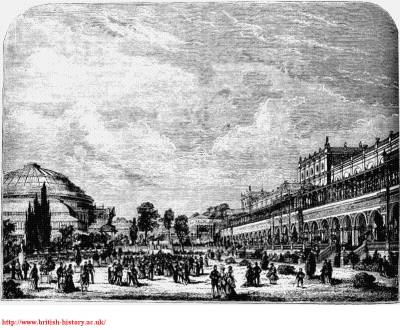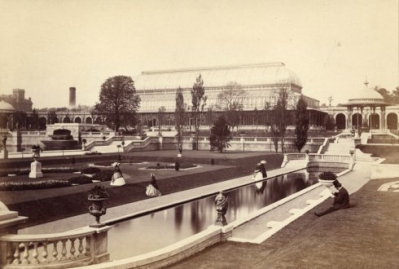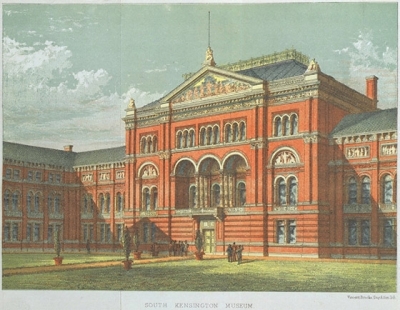To search the RPR site click here
In 1878 the objects that Pitt-Rivers had loaned to Bethnal Green Museum were moved to South Kensington to the main brach of the museum. This museum would later become known as the Victoria and Albert Museum. Pitt-Rivers' collection remained there until it transferred to the University of Oxford in 1885.
Pitt-Rivers' collections formed part of the Educational Series at the Museum and were exhibited slightly separately in an annexe on the other side of the Exhibition Road, in two galleries alongside the then Horticultural Gardens (the galleries no longer form part of the V&A).[1] The galleries were the north end of Gallery L and Room K (as the extract from the 1878 catalogue given below shows). An photograph of 'Room L (Loan Collection)' in 1876, held by the Science Museum, is shown here. [2] If this image shows the right Room L then it must show the southern end of the gallery (the opposite end to the one where Pitt-Rivers collection were later displayed, as the full length windows were on the eastern side of the gallery (the galleries were on the far side of the site, away from Exhibition Road, which runs north-south as I have assumed did Room L).
The galleries were used to display a loan collection of scientific apparatus from 1876 [Burton, 1999: 120] Lane Fox's collection replaced a display of a map and print of old London collection belonging to Frederick Crace. [Burton, 1999: 124] Burton considers this loan collection from Lane Fox to be 'even more inapposite' than Crace. [1999: 124]
 The history of the South Kensington Museum was bound up in the development of the British government's role in education and in the provision of art training in a very complex way. One attempt to explain it is given in wikipedia, but a clearer account can be found in a pdf by Bruce Robertson, available here. In it he explains:
The history of the South Kensington Museum was bound up in the development of the British government's role in education and in the provision of art training in a very complex way. One attempt to explain it is given in wikipedia, but a clearer account can be found in a pdf by Bruce Robertson, available here. In it he explains:
The educational nature of the [South Kensington] Museum defined it in fundamental ways. For example, the Museum’s unique relationship to the government derived from its central role in education. Unlike the British Museum or the National Gallery, which had independent boards of trustees, the South Kensington Museum was a department of government. But even this statement is not quite accurate: the Museum was an element of an educational program that was a department of the government. The museum grew out of the activities of the School of Design and was derived from the collections used to support the School’s teaching. The School of Design had been established in 1836, in response to the work of a Select Committee on the arts of design and the Royal Academy’s teaching function.It reported to the Board of Trade and in 1837 opened in Somerset House. The creation of the School was part of a larger program of government interest in education (indeed, part of the larger liberal program of reform): the University of London was also formed in 1836 and in 1839 the first government body was established to administer elementary education, the Committee of the Privy Council on Education. When Cole, fresh from the triumph of the 1851 Exhibition, was charged with reforming the School of Design, it became part of a newly formed Department of Practical Art in 1852, under the Board of Trade. In 1856, the Department of Science and Art, as it was now named, was transferred to the Privy Council, under the Committee of Council for Education. This Committee had two bodies reporting to it: the Department of Education responsible for primary school education and the Department of Science and Art ... In other words, the South Kensington Museum was a school that had a collection to which the public was also admitted.
Find out more about Pitt-Rivers' relationship with South Kensington Museum between 1878 and 1885 here.
A common feature of both South Kensington Museum and its branch museum at Bethnal Green, during this period was a strong reliance on loan collections to form exhibits, 'From the late 1860s to the early 1880s, in numerical terms, loans consistently accounted for about one third of the gallery displays of the art collections'. [Eatwell, 2000: 21] Eatwell makes it clear that most loans were short-term, lasting around 2-3 years; so Pitt-Rivers' loan which stayed at the Bethnal Green/ South Kensington Museums for 10 years was an exception.
The third image shown on this page is of the South Kensington Museum in 1869, originally shown here [VA 1868.005]. Some fifteen years after the museum opened, Pitt-Rivers agreed to loan some musical instruments to an exhibition, two years later he agreed to loan a substantial proportion of his private collection to a branch of the South Kensington Museum housed at Bethnal Green, in 1878 this display was transferred to South Kensington Museum where it was housed in some exhibition galleries beside the Horticultural Gardens, on the other side of Exhibition Road, where SKM put loan collections (the first two images on this page show these galleries). The following quotation is from Pitt-Rivers' published catalogue of the collection:
Note to catalogue, page xvi: This Collection, which has for the past four years been exhibited at the Branch Museum at Bethnal Green, has lately been removed to South Kensington. It is arranged in two rooms in the Exhibition Galleries on the western side of the Horticultural Gardens, and may be reached either by the entrance in Queen's Gate, or by that in Exhibition Road.
The portion of the Collection treated of in the Catalogue already published (Parts I and II) has been arranged, as far as the building will allow, in the same order as before [see below]. It begins with Case I (Typical Human Skulls, etc.,) which will be found by the Queen's Gate Entrance at the north end of Room L. The Screens begin with No. 2 on the EAST Wall of this room, and follow in consecutive order, bearing the same numbers as in the Catalogue, to No. 39 in the adjoining room (K). Deviations from this order are indicated on the walls.
The portions of the Collection shown in cases in the middle of the Galleries and on the WEST wall will, it is proposed, be treated of in Parts III. and IV. of the Catalogue to be published hereafter (see note on page vii).
South Kensington Museum
7th January 1879
[Taken from ‘Catalogue of the Anthropological Collection lent by Colonel Lane Fox for exhibition in the Bethnal Green branch of the South Kensington Museum June 1874 ... Parts I and II’ London, 1879: frontispiece][2]
The history of the South Kensington Museum
The Museum was founded in 1852 as part of the aftermath of the Great Exhibition in Hyde Park in London of 1851. Henry Cole was its first Director and it was originally known as 'The Museum of Manufactories'. Before it moved to South Kensington Museum it had been sited at Marlborough House, but several months later it moved to Somerset House. The new museum in South Kensington was opened by Queen Victoria on 22 June 1857.
The museum was described in 1878 as:
On the opposite side of the Exhibition Road, and with its principal entrance in Cromwell Road, is the South Kensington Museum, together with the various Science and Art Schools which have been established, under Government, in connection therewith. This Museum, which now contains upwards of 20,000 rare and choice examples of Mediæval and Modern Art workmanship, originated in the year 1852 with a small collection, exhibited in Marlborough House in connection with the Schools of Art. In 1857 the collection was transferred hither to some temporary iron buildings which had been erected for its reception, which, from their material, and from some peculiarities of construction, became popularly known as the "Brompton Boilers." These temporary buildings have been gradually replaced by a permanent edifice. From the year 1853 the Museum has included objects contributed on loan by private owners. In 1862—the year of the second International Exhibition—a special "loan exhibition" of works, chiefly of Mediæval and Renaissance Art, was held here; and since that time the number of objects on loan has always been considerable. By this means very many of the rarest and most precious examples of art workmanship in this country have been generously permitted by their owners to be seen and leisurely studied by the public. In addition to the "loans," many objects have been acquired by purchase, gift, and bequest; besides which are reproductions, by the electrotype process and in plaster, of objects in other collections which have been judged to be of special interest and value to the art student.
The plan of the Museum is somewhat irregular, and covers a large space of ground—about twelve acres in extent—acquired by the Government, at a cost of £60,000, being a portion of the estate purchased by Her Majesty's Commissioners for the Exhibition of 1851, out of the surplus proceeds of that undertaking. The buildings, with their courts and galleries, are constructed chiefly of brick, somewhat profusely ornamented with terra-cotta, and were built from the designs of Captain Fowke, R.E. The art collections are chiefly contained in three large courts and a long range of cloisters on the ground floor; but many rare and valuable objects are shown in the picture-galleries, and also in what is called the Prince Consort Gallery. The visitor, on entering the Museum from the Cromwell Road, passes through a long corridor to the South Court, a lofty and spacious building, surrounded with galleries, and rich in ornamentation. The upper portion of the walls is divided into thirtysix alcoves (eighteen on either side), containing portraits, in mosaic, of eminent men of all ages connected with the arts, especially those who have been distinguished as ornamentalists, or as workers in bronze, marble, or pottery. ... The North Court is specially appropriated to the exhibition of Italian sculpture, and architectural models and casts. Many of the most beautiful of these objects are, so to speak, incorporated into the building, the decoration of which is much simpler than that of the South Court. In the east arcade of this court are some textile or woven fabrics, of European origin, including several ecclesiastical vestments and rare fragments of mediæval embroidery. Through the windows of the north arcade is seen the "fernery," which was designed to enable the students in training as art-teachers to draw from plants at all seasons. A considerable portion of the west arcade forms the reading-room of the Art Library. The staircase leading to the galleries is lighted by a large stained-glass window, the subject of which was suggested by a passage in Ecclesiasticus, chapter xxxviii., descriptive of trades. The keramic, or pottery gallery, contains a large collection of Wedgwood's jasper and other wares, and also examples of the porcelain of Bow, Chelsea, Bristol, Plymouth, Worcester, and Derby. Here, too, are represented the great manufacturers of pottery of the present day in Italy, France, and England. The next gallery into which the visitor passes contains a collection of Venetian, German, and other ancient glass vessels. In the Prince Consort Gallery are placed many of the most interesting and costly possessions of the Museum, in enamel, gold, and silversmith's work, jewellery, watches, clocks, &c.
Three staircases in different parts of the building lead to the Picture Galleries, which are above the cloisters of the North and South Courts. Several rooms or galleries are devoted to the National Collection of Pictures by British artists. ... Passing through the door at the east end of the gallery, we enter the rooms containing the Sheepshanks' Collection of Paintings. ... The Museum of Patents, adjoining the South Court, is a collection illustrative of the progress of national invention, and contains not only models, but several original machines which have been the means of developing our prosperity, and have given new life to the world. ... On the west side of the main buildings of the Museum, facing the Exhibition Road, is a large edifice, containing class-rooms for instruction in various branches of science. ...The Royal Horticultural Society, whose gardens, as we have already stated, are enclosed by the Exhibition buildings on the south side of the Royal Albert Hall, was established in 1804, and incorporated by royal charter soon afterwards. ... In 1859 the society obtained (through the late Prince Consort) possession of about twenty acres of land on this site, and new and splendid gardens were laid out. These were opened in the summer of 1862, forming a charming retreat from the bustle of the Exhibition. [From 'West Brompton and the South Kensington Museum', Old and New London: Volume 5(1878), pp. 100-117. Available here]
See here for more information about the Bethnal Green and South Kensington Museum displays
AP, 2010, revised heavily August 2011, December 2011
Notes
[1] 'This Collection, which has for the past four years been exhibited in the Branch Museum at Bethnal Green, has lately been removed to South Kensington. It is arranged in two rooms in the Exhibition Galleries on the western side of the Horticultural Gardens, and may be reached either by the entrance in Queen's Gate, or by that in Exhibition Road' [Note to catalogue page xvi, at front of 1878 second edition of the 1874 Catalogue of Pitt-Rivers collection]
[2] My thanks to Christopher Morton for finding this image.
[2] The original note in the catalogue of 1874 had said 'Note: The collection to which this Catalogue relates occupies the whole of the South Basement of the Museum buildings [at Bethnal Green Branch Museum]. The series commences at the East End with the typical human skulls and hair of different races, and then proceeds with specimens of the culture of modern savages and barbarous races; these are arranged along the line of Screens and Walls on the South Side from East to West, and along the North Wall and in upright glass cases from West to East. After these the pre-historic series commences on the West, and runs along the line of desk cases from West to East. Where necessary, arrows are painted on the Screens, indicating the sequence in which the objects thereon have been arranged.' Parts III and IV were never published (or even drafted, so far as is known), the note on page vii of the catalogue states 'Parts III and IV. to be published hereafter, and will relate, the former to modes of navigation, representative arts of savage and early races, ornamentation, personal ornament, pottery and substitutes for pottery, tools, deities and religious emblems, clothing and weaving, fire-arms, and illustrations of the modes of hafting stone implements. Part IV. will be devoted to the prehistoric series, and will include natural forms, simulating artificial forms, illustrations of forgeries and modern fabrications, palaeolithic implements, neolithic implements, bronze implements, and iron implements, with the stone implements of modern savages, adapted to the illustration of pre-historic times.'
Bibliography for this article
Baker, M. and Richardson, B. eds. (1997) A Grand Design: The Art of the Victoria and Albert Museum, London: V & A Publications.
Burton, A. (1999) Vision & Accident: The Story of the Victoria and Albert Museum, London: V& A Publications.
Eatwell, Anne. 2000. 'Borrowing from Collectors: The role of the Loan in the Formation of the Victoria and Albert Museum and its Collection (1852-1932)'. Decorative Arts Society Journall 24 (2000): 21-29.
Denis, R. C. (1997) ‘Teaching by Example: Education and the Formation of South Kensington’s Museums’ in M. Baker and B. Richardson (eds). (1997) A Grand Design: The Art of the Victoria and Albert Museum, London: V & A Publications.
Robertson, Bruce. 2004. 'The South Kensington Museum in context: an alternative history' Museum and Society March 2004 2 (1) 1-14





